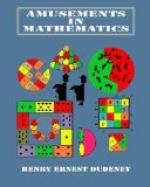The second diagram is a most favourable magic square position. It will be seen that prisoners 4, 8, 13, and 14 are left in their original cells. This position may be reached in as few as thirty-seven moves. Here are the moves: 15, 14, 10, 6, 7, 3, 2, 7, 6, 11, 3, 2, 7, 6, 11, 10, 14, 3, 2, 11, 10, 9, 5, 1, 6, 10, 9, 5, 1, 6, 10, 9, 5, 2, 12, 15, 3. This short solution will probably surprise many readers who may not find a way under from sixty to a hundred moves. The clever prisoner was No. 6, who in the original illustration will be seen with his arms extended calling out the moves. He and No. 10 did most of the work, each changing his cell five times. No. 12, the man with the crooked leg, was lame, and therefore fortunately had only to pass from his cell into the next one when his time came round.
404.—THE SIBERIAN DUNGEONS.
[Illustration]
+-----+-----+-----+-----+ | | | | | | 8 | 5 | 10 | 11 | |_____|_____|_____|_____| | | | | | | 16 | 13 | 2 | 3 | |_____|_____|_____|_____| | | | | | | 1 | 12 | 7 | 14 | |_____|_____|_____|_____| | | | | | | 9 | 4 | 15 | 6 | | | | | | +-----+-----+-----+-----+
In attempting to solve this puzzle it is clearly necessary to seek such magic squares as seem the most favourable for our purpose, and then carefully examine and try them for “fewest moves.” Of course it at once occurs to us that if we can adopt a square in which a certain number of men need not leave their original cells, we may save moves on the one hand, but we may obstruct our movements on the other. For example, a magic square may be formed with the 6, 7, 13, and 16 unmoved; but in such case it is obvious that a solution is impossible, since cells 14 and 15 can neither be left nor entered without breaking the condition of no two men ever being in the same cell together.
The following solution in fourteen moves was found by Mr. G. Wotherspoon: 8-17, 16-21, 6-16, 14-8, 5-18, 4-14, 3-24, 11-20, 10-19, 2-23, 13-22, 12-6, 1-5, 9-13. As this solution is in what I consider the theoretical minimum number of moves, I am confident that it cannot be improved upon, and on this point Mr. Wotherspoon is of the same opinion.
405.—CARD MAGIC SQUARES.
Arrange the cards as follows for the three new squares:—
3 2 4 6 5 7 9 8 10 4 3 2 7 6 5 10 9 8 2 4 3 5 7 6 8 10 9
Three aces and one ten are not used. The summations of the four squares are thus: 9, 15, 18, and 27—all different, as required.
406.—THE EIGHTEEN DOMINOES.
[Illustration]
The illustration explains itself. It will be found that the pips in every column, row, and long diagonal add up 18, as required.
407.—TWO NEW MAGIC SQUARES.
Here are two solutions that fulfil the conditions:—




